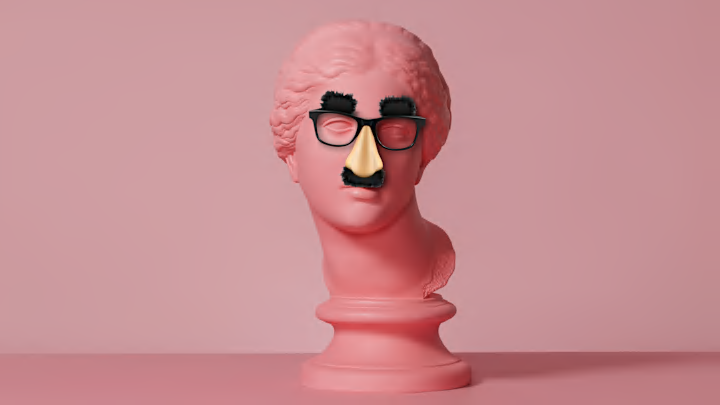It's not known for certain where or why April Fools' Day originated. Some say the humorous holiday goes back to a Roman festival or events in the Bible, while others point to a change in the calendar in 16th-century France. According to the theory, people in various regions across the country marked the new year on different dates, and when the King of France, Charles IX, signed the Edict of Roussillon and standardized the new year to January 1, not everybody got the memo. This led some to continue celebrating the new year around April, and therefore become the butt of jokes.
What we do know is that, at some point, duping people on April 1 became something of a pastime. One of the most common early pranks was to send potential “fools” on impossible tasks—literally, on a fool’s errand—to look for “a bucket of striped paint, a bucket of steam, pigeon milk, a jar of elbow grease,” writes folklorist Nancy Cassell McEntire. In the spirit of good-hearted tomfoolery, here are seven more great pranks from history.
1. Rome’s Most Unbearable Party Stunt

Considered one of the most incompetent Roman emperors, the teenage Elagabalus was, if nothing else, a solid prankster. According to archaeologist Warwick Ball’s book Rome in the East, Elagabalus routinely seated “his more pompous dinner guests on ‘whoopee cushions’ that let out a farting noise.” Purportedly, the emperor also thought it was funny to release snakes in public. One of his favorite stunts, supposedly, was to place a tamed bear, lion, or leopard in the rooms of his sleeping, drunken guests.
2. Anthemius’s Fake Earthquake Machine
Anthemius of Tralles, a 5th-century Greek architect who helped build Istanbul’s Hagia Sophia, knew his way around a toolbox. So when a feud erupted between him and his neighbor, Zeno, Anthemius knew exactly what to do. The architect erected several boilers of water in his house and connected them to a hose, which he fed into a small hole leading into Zeno’s cellar next door. According to the 1888 Magazine of Western History, “When Anthemius desired to annoy his neighbor, he lighted fires under his boilers, and the steam produced by them rushed in such quantity and with such force under Zeno’s floors that they were made to heave with all the usual symptoms of an earthquake.”
3. The Misleading Monk’s Apple Trick
One of the earliest documented pranks dates to the late 15th century, when Thomas Betson, a monk at England’s Syon Abbey, hollowed out the core of an apple and inserted a large beetle, causing the fruit to rock back and forth. And that wasn’t the only trick hidden up the monk’s tunic: Betson was also a fan of making objects in the monastery levitate. Using a strand of fine hair and wax, he could suspend a hollow egg in midair.
4. London’s Washing of the Lions

For centuries, the Tower of London was home to a menagerie of wild animals, from polar bears to lions and even a beer-drinking zebra. On April Fools’ Day in 1698, a clever trickster convinced a handful of people the lions were receiving their annual bath. No such event existed, but that didn’t stop hordes of gawkers from visiting the Tower to have a look. For the next two centuries, the con remained a running gag, even long after the last lion left the Tower. By the 19th century, tricksters were distributing fake tickets to the “Annual Ceremony of the Washing of the Lions.”
5. The English Mercurie: The Prank Newspaper That Keeps On Pranking
Philip Yorke, a Cambridge-educated member of British Parliament and the Second Earl of Hardwicke, used his privilege to pull off some grade-A pranking. In the 1740s, he and his friend Thomas Birch printed The English Mercurie, a phony newspaper purportedly published in 1588—a date that, if true, would make it one of the world's first newspapers. In 1766, Birch gifted the paper, along with other documents, to the British Museum, which treated the publication as legitimate for decades. In fact, the “information” in the fake news report is still erroneously used today! Even the paper's Wikipedia page calls out other Wikipedia entries for citing The English Mercurie as a legitimate source.
6. The New York Sun’s Moon Hoax

On August 25, 1835, readers of the New York Sun were stunned to learn there was a civilization on the Moon. An English astronomer, the paper reported, had traveled to the Southern Hemisphere to study the night’s sky and, upon glancing at the Moon, discovered vegetation, pyramids, unicorns, bipedal beavers, and humanoid creatures with wings. The story, of course, was fake. The series of satirical articles aimed to poke fun at people like science writer Thomas Dick, who had recently claimed the Moon was home to an alien population of more than 4 billion extraterrestrials. Unfortunately, the Sun underestimated the public’s gullibility. News of the “discovery” spread across the globe.
7. William Buckland’s Guano Graffiti
A 19th-century paleontologist and poop expert—yes, poop expert—William Buckland believed guano was the next great lawn fertilizer. As an undergrad at Oxford, he proved his point by carefully sprinkling a bucket of bat guano across one of the university’s lawns, spelling out the word GUANO. Officials quickly noticed the feces and removed it. Little did they know, however, that the fertilizer had invigorated the grass below. Within weeks, the word GUANO was growing in the university’s lawn—and university officials had no way to remove it. According to Buckland’s biographer, “[T]he brilliant green grass of the letters amply testified to [guano’s] efficacy as a dressing.”
A version of this story ran in 2020; it has been updated for 2022.
